Sakurajima "Kagoshima, Japan"
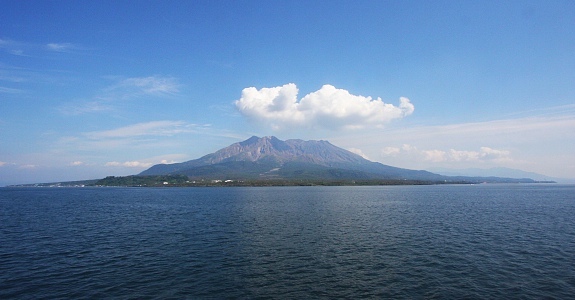
Sakurajima is one of Japan's most active volcanoes and the symbol of Kagoshima. The volcano smokes constantly, and minor eruptions often take place multiple times per day. Located in the middle of Kagoshima Bay, Sakurajima is the area's most prominent geographic feature, having an elevation of 1117 meters and a circumference of about 50 kilometers.
Before a powerful eruption in 1914, Sakurajima used to be an island in the bay, but the massive lava flow from that eruption created the volcano's current land connection to the Osumi Peninsula in the east. For the majority of travelers, however, the volcano is still most easily accessed by the ferries that run the 3.5 kilometers between Kagoshima Port and the Sakurajima Ferry Terminal.
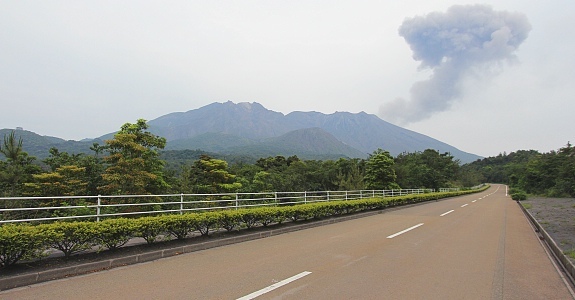
An eruption from the Showa Crater seen from the road
Sakurajima has three main peaks: Kita-dake ("north peak", 1117 meters), Naka-dake ("middle peak" 1060 meters) and Minami-dake ("southern peak", 1040 meters). The Minami-dake peak is currently the most active, with many eruptions taking place from the Showa Crater on the peak's eastern slope. It is prohibited to approach within two kilometers of the volcano's craters, but there are many observation points around Sakurajima where eruptions can be observed from about three kilometers away.
Travelers visiting Sakurajima can find many attractions just around the Ferry Terminal, including an onsen, foot baths, short hiking trails and an information center. Those who would like to further explore the volcano should travel by rental car, which can be taken across the water from Kagoshima by the ferries. Sightseeing buses, regular buses and rental bicycles are other possible methods of travel.
Around the Ferry Terminal
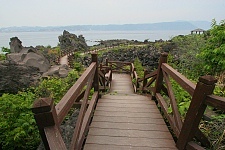
About three kilometers of walking trails extend along the water beside the Sakurajima Ferry Terminal. The trail cuts through a lava zone created by the giant eruption of 1914. Travelers can observe the growth of grasses and short plants that has taken place since the eruption that occurred about 100 years ago.
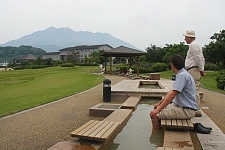
Nagisa Park Foot Bath
These pleasant foot baths are free of charge and are a great place to take a break and observe the volcano. The baths are very long and stretch for dozens of meters. From the baths there are also decent views onto the bay and across the water to Kagoshima City.
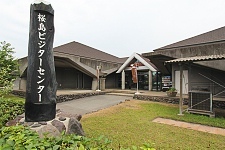
Sakurajima Visitor Center
Hours: 9:00 to 17:00
Admission: Free
Closed: No closing days
This small visitor center is free of charge and has models, pictures, videos and information boards about Sakurajima. Much of the information is also provided in English.
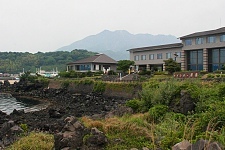
Magma Onsen
Hours: 10:00 to 22:00
Admission: 300 yen
Closed: No closing days
Part of a larger tourist facility that includes a hotel, shops and restaurants, the Magma Onsen has hot spring baths that are open to day trippers. The baths have large windows that look out across the water to Kagoshima City, however, on the whole, they are rather mediocre.
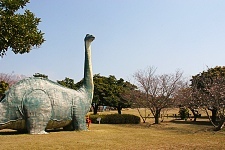
Dinosaur Park
This unique park is located on a hill about a 15 minute walk from the ferry terminal. The park takes its name from the seven life size dinosaur statues that are scattered around its grounds. The park is good for travelers with kids as it has jungle gym equipment. The park's cherry trees make it a particularly attractive destination in early spring when the flowers are in bloom.
Elsewhere around Sakurajima
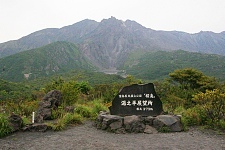
Yunohira Observation Point
Of Sakurajima's main observation points, the Yunohira Observation Point is the closest to the ferry terminal. It is also the closet to Sakurajima's crater, about 2.5 kilometers away, and has the highest elevation at 350 meters. It is located along the volcano's western slope.
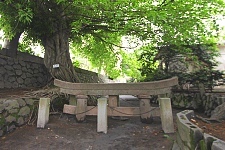
Kurokami Shrine Gate
Travelers can get a sense of the size of the 1914 eruption by visiting the Kurokami Shrine Gate. The same eruption that caused the land connection of Sakurajima to the Osumi Peninsula covered the shrine's torii gate in volcanic ash, leaving only the very top still visible above ground.
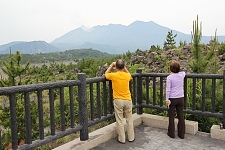
Kurokami Observation Point
The Kurokami Observation Point is located a few hundred meters from the Kurokami Shrine Gate close to the volcano's eastern coast. Just alongside the main road, the observation point has a slightly raised observation platform in front of a long flat terrain before the volcano rises. From this area travelers can get good views of the Showa Crater and its frequent small eruptions.
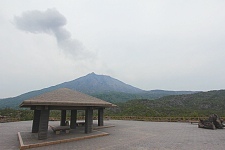
Arimura Observation Point
The Arimura Observation Point gives a view onto Sakurajima's craters from a slight elevation of about 75 meters. The observation area has a number of lookout points that are connected by paved walking paths. The walking paths make for a nice little hike. There are also nice views of Sakurajima's coastline.